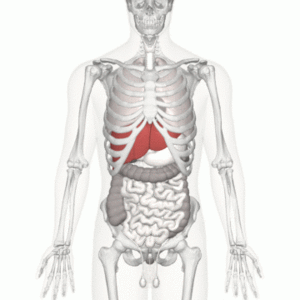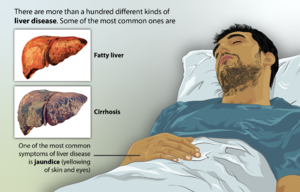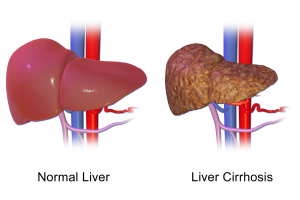Liver Function Tests: Difference between revisions
No edit summary |
Kim Jackson (talk | contribs) m (Text replacement - "[[Human Immunodeficiency Virus (HIV)/AIDS" to "[[Human Immunodeficiency Virus (HIV)") |
||
| (12 intermediate revisions by 3 users not shown) | |||
| Line 1: | Line 1: | ||
<div class=" | <div class="editorbox"> '''Original Editor '''- [[User:Shwe Shwe U Marma|Shwe Shwe U Marma]] '''Top Contributors''' - {{Special:Contributors/{{FULLPAGENAME}}}}</div> | ||
== Introduction == | |||
[[File:Liver gif.gif|right|frameless]] | |||
[[Liver Disease|Liver]] Function Tests (LFTs) are used to screen for, detect, evaluate and monitor acute and chronic liver inflammation ([[Hepatitis A, B, C|hepatitis]]), [[Infectious Disease|infection]], liver disease and/or damage. The liver is one of the largest organs in the body and is located in the upper right-hand part of the abdomen and behind the lower [[ribs]]. | |||
* The liver has several functions including eg: primary detoxification of various metabolites; synthesizing [[Muscle Function and Protein|proteins]]; producing digestive [[enzymes]]; a role in metabolism; regulation of red [[Blood Physiology|blood]] cells; glucose synthesis and storage; vitamin and mineral storage.<ref name=":2">Lala V, Goyal A, Bansal P, Minter DA. [https://www.ncbi.nlm.nih.gov/books/NBK482489/ Liver function tests]. StatPearls [Internet]. 2020 Jul 4.Available from: https://www.ncbi.nlm.nih.gov/books/NBK482489/<nowiki/>(accessed 27.3.2021)</ref> <ref name=":3">Lab tests inline [https://www.labtestsonline.org.au/learning/test-index/liver-function LFTs] Available from: https://www.labtestsonline.org.au/learning/test-index/liver-function<nowiki/>(accessed 27.3.2021)</ref>. | |||
The liver function tests are one of the most commonly ordered laboratory tests. Mild isolated elevations in LFTs can be seen as normal fluctuations and should not trigger expensive and extensive workup. | |||
* The term “liver function tests“ is a misnomer as many of the tests do not comment on the function of the liver but rather pinpoint the source of the damage. | |||
* Physicians need be aware of various conditions that can lead to an elevation in LFTs.<ref name=":2" /> | |||
== | == What LFTs Reveal == | ||
[[File:Liver disease.png|right|frameless]] | |||
A variety of diseases and infections can cause acute or chronic damage to the liver, causing inflammation, scarring, bile duct obstructions, clotting abnormalities, and liver dysfunction. Alcohol, drugs, some herbal supplements, and toxins can also pose a threat. A significant amount of liver damage may be present before symptoms such as jaundice, dark urine, light-coloured stools, pruritus, nausea, fatigue, diarrhoea, and unexplained weight loss or gain emerge. Early detection is essential in order to minimize damage and preserve liver function. | |||
* LFTs measure enzymes, proteins, and substances that are produced or excreted by the liver and are affected by liver injury. | |||
* Some are released by damaged liver cells and some reflect a decrease in the liver's ability to perform one or more of its functions. | |||
* When performed together, these tests give the doctor a snapshot of the health of the liver, an indication of the potential severity of any liver injury, change in liver status over time, and a starting place for further diagnostic testing<ref name=":3" /> | |||
== Etiology and Epidemiology == | |||
Elevated LFTs are found in approximately 8% of the general population. These elevations may be transient in patients without symptoms with up to 30% elevations resolving after 3 weeks. ie care should be taken when interpreting these results to avoid unnecessary testing<ref name=":2" /> | |||
== Significance == | |||
[[File:Liver cirrhosis.png|right|frameless]] | |||
LFT results are not diagnostic of a specific condition; they indicate that there may be a problem with the liver. In a person who does not have symptoms or identifiable risk factors, abnormal liver test results may indicate a temporary liver injury or reflect something that is happening elsewhere in the body eg in the skeletal muscles, pancreas, or heart. It may also indicate early liver disease and the need for further testing and/or periodic monitoring. | |||
Potential Diagnoses include: | |||
* [[Alcoholism]] eg Liver fibrosis can also be seen as secondary to chronic alcohol intake | |||
* Fatty liver disease can cause chronic hepatic disease as well as hepatocellular carcinoma. The typical patient with this disease is overweight, has type II diabetes, or has dyslipidemia and no evidence of clinically significant alcohol use | |||
* Viral [[Hepatitis A, B, C|Hepatitis]]: Viral illnesses are a common cause of hepatitis and elevation in LFTs. Viral hepatitis B, C, and D can cause chronic hepatitis; hepatitis A and E cause acute viral hepatitis. Several other viruses including [[Human Immunodeficiency Virus (HIV)|HIV]], [[Epstein-Barr Virus|Epstein-Barr]] (EBV) and [[Cytomegalovirus (CMV) Infection|Cytomegalovirus]] (CMV) can also cause hepatitis. | |||
*[[File:Hospital.jpeg|right|frameless]]Medications are known to cause liver damage. eg. many of these are commonly used in daily practice including but not limited to [[NSAID Gastropathy|NSAID]]<nowiki/>s, [[antibiotics]], statins, anti-seizure drugs, antifungals such as ketoconazole, and drugs for [[tuberculosis]] treatment. | |||
* [[Hemochromatosis]] is the abnormal accumulation of iron in parenchymal organs, leading to organ toxicity. It is the most common autosomal recessive [[Genetic Disorders|genetic disorder]] and the most common cause of severe iron overload. | |||
* [[Autoimmune Disorders|Autoimmune]] hepatitis is a chronic disease that is characterized by continuing hepatocellular inflammation and necrosis and a tendency to progress to cirrhosis. | |||
* [[Wilson's Disease|Wilson disease]], a rare autosomal-recessive inherited disorder of copper metabolism, is characterized by excess copper deposition in the liver, brain, and other tissues. It is fatal if not recognized and treated early. | |||
* Alpha-1 antitrypsin deficiency (AATD) is a relatively common yet often undiagnosed genetic condition. Those with AATD are also predisposed to [[COPD (Chronic Obstructive Pulmonary Disease)|obstructive pulmonary disease]] and liver disease<ref name=":2" /> | |||
Follow up tests if deemed appropriate include: | |||
{| class="wikitable" | {| class="wikitable" | ||
|Suspected type of liver disorder | |||
|Other or follow-up tests | |||
|- | |||
|Viral infection | |||
|Hepatitis A, B, or C | |||
|- | |- | ||
| | |Alcohol abuse/hepatitis | ||
|Ethanol | |||
|- | |- | ||
| | |Toxic or drug-induced | ||
|Tests for toxins, drugs including drugs of abuse screen | |||
| | |||
|- | |- | ||
|' | |Wilson's disease | ||
|Copper, Caeruloplasmin | |||
|- | |- | ||
| | |Autoimmune | ||
|ANA, SMA | |||
|- | |- | ||
| | |Chronic | ||
|Liver biopsy | |||
| | |||
|- | |- | ||
| | |Liver cancer | ||
|AFP (Alpha-fetoprotein) | |||
|} | |} | ||
<ref name=":3" /> | |||
== References | == Components of Liver Function Tests == | ||
The panel usually consists of several tests that are run at the same time on a blood sample. These may include: | |||
* Alanine aminotransferase (ALT) – an enzyme mainly found in the liver; the best test for detecting hepatitis | |||
* Alkaline phosphatase (ALP) – an enzyme related to the bile ducts; often increased when they are blocked | |||
* Aspartate aminotransferase (AST) – an enzyme found in the liver and a few other places, particularly the heart and other muscles in the body | |||
* Total bilirubin – measures all the yellow bilirubin pigment in the blood. Another test, direct bilirubin, measures a form combined with another compound in the liver and is often requested with total bilirubin in infants with jaundice. | |||
* Albumin – measures the main protein made by the liver and tells whether or not the liver is making an adequate amount of this protein | |||
* Gamma-glutamyl transferase (GGT) - an enzyme found mainly in the liver and is a useful marker for detecting bile duct problems | |||
* Total protein - measures albumin and all other proteins in blood, including [[Immunoglobulins (Ig)|antibodies]] made to help fight off infections<ref name=":3" /> | |||
== References == | |||
<references /> | <references /> | ||
[[Category:Physiology]] | [[Category:Physiology]] | ||
[[Category:Assessment]] | [[Category:Assessment]] | ||
Latest revision as of 13:31, 2 December 2021
Introduction[edit | edit source]
Liver Function Tests (LFTs) are used to screen for, detect, evaluate and monitor acute and chronic liver inflammation (hepatitis), infection, liver disease and/or damage. The liver is one of the largest organs in the body and is located in the upper right-hand part of the abdomen and behind the lower ribs.
- The liver has several functions including eg: primary detoxification of various metabolites; synthesizing proteins; producing digestive enzymes; a role in metabolism; regulation of red blood cells; glucose synthesis and storage; vitamin and mineral storage.[1] [2].
The liver function tests are one of the most commonly ordered laboratory tests. Mild isolated elevations in LFTs can be seen as normal fluctuations and should not trigger expensive and extensive workup.
- The term “liver function tests“ is a misnomer as many of the tests do not comment on the function of the liver but rather pinpoint the source of the damage.
- Physicians need be aware of various conditions that can lead to an elevation in LFTs.[1]
What LFTs Reveal[edit | edit source]
A variety of diseases and infections can cause acute or chronic damage to the liver, causing inflammation, scarring, bile duct obstructions, clotting abnormalities, and liver dysfunction. Alcohol, drugs, some herbal supplements, and toxins can also pose a threat. A significant amount of liver damage may be present before symptoms such as jaundice, dark urine, light-coloured stools, pruritus, nausea, fatigue, diarrhoea, and unexplained weight loss or gain emerge. Early detection is essential in order to minimize damage and preserve liver function.
- LFTs measure enzymes, proteins, and substances that are produced or excreted by the liver and are affected by liver injury.
- Some are released by damaged liver cells and some reflect a decrease in the liver's ability to perform one or more of its functions.
- When performed together, these tests give the doctor a snapshot of the health of the liver, an indication of the potential severity of any liver injury, change in liver status over time, and a starting place for further diagnostic testing[2]
Etiology and Epidemiology[edit | edit source]
Elevated LFTs are found in approximately 8% of the general population. These elevations may be transient in patients without symptoms with up to 30% elevations resolving after 3 weeks. ie care should be taken when interpreting these results to avoid unnecessary testing[1]
Significance[edit | edit source]
LFT results are not diagnostic of a specific condition; they indicate that there may be a problem with the liver. In a person who does not have symptoms or identifiable risk factors, abnormal liver test results may indicate a temporary liver injury or reflect something that is happening elsewhere in the body eg in the skeletal muscles, pancreas, or heart. It may also indicate early liver disease and the need for further testing and/or periodic monitoring.
Potential Diagnoses include:
- Alcoholism eg Liver fibrosis can also be seen as secondary to chronic alcohol intake
- Fatty liver disease can cause chronic hepatic disease as well as hepatocellular carcinoma. The typical patient with this disease is overweight, has type II diabetes, or has dyslipidemia and no evidence of clinically significant alcohol use
- Viral Hepatitis: Viral illnesses are a common cause of hepatitis and elevation in LFTs. Viral hepatitis B, C, and D can cause chronic hepatitis; hepatitis A and E cause acute viral hepatitis. Several other viruses including HIV, Epstein-Barr (EBV) and Cytomegalovirus (CMV) can also cause hepatitis.
- Medications are known to cause liver damage. eg. many of these are commonly used in daily practice including but not limited to NSAIDs, antibiotics, statins, anti-seizure drugs, antifungals such as ketoconazole, and drugs for tuberculosis treatment.
- Hemochromatosis is the abnormal accumulation of iron in parenchymal organs, leading to organ toxicity. It is the most common autosomal recessive genetic disorder and the most common cause of severe iron overload.
- Autoimmune hepatitis is a chronic disease that is characterized by continuing hepatocellular inflammation and necrosis and a tendency to progress to cirrhosis.
- Wilson disease, a rare autosomal-recessive inherited disorder of copper metabolism, is characterized by excess copper deposition in the liver, brain, and other tissues. It is fatal if not recognized and treated early.
- Alpha-1 antitrypsin deficiency (AATD) is a relatively common yet often undiagnosed genetic condition. Those with AATD are also predisposed to obstructive pulmonary disease and liver disease[1]
Follow up tests if deemed appropriate include:
| Suspected type of liver disorder | Other or follow-up tests |
| Viral infection | Hepatitis A, B, or C |
| Alcohol abuse/hepatitis | Ethanol |
| Toxic or drug-induced | Tests for toxins, drugs including drugs of abuse screen |
| Wilson's disease | Copper, Caeruloplasmin |
| Autoimmune | ANA, SMA |
| Chronic | Liver biopsy |
| Liver cancer | AFP (Alpha-fetoprotein) |
Components of Liver Function Tests[edit | edit source]
The panel usually consists of several tests that are run at the same time on a blood sample. These may include:
- Alanine aminotransferase (ALT) – an enzyme mainly found in the liver; the best test for detecting hepatitis
- Alkaline phosphatase (ALP) – an enzyme related to the bile ducts; often increased when they are blocked
- Aspartate aminotransferase (AST) – an enzyme found in the liver and a few other places, particularly the heart and other muscles in the body
- Total bilirubin – measures all the yellow bilirubin pigment in the blood. Another test, direct bilirubin, measures a form combined with another compound in the liver and is often requested with total bilirubin in infants with jaundice.
- Albumin – measures the main protein made by the liver and tells whether or not the liver is making an adequate amount of this protein
- Gamma-glutamyl transferase (GGT) - an enzyme found mainly in the liver and is a useful marker for detecting bile duct problems
- Total protein - measures albumin and all other proteins in blood, including antibodies made to help fight off infections[2]
References[edit | edit source]
- ↑ 1.0 1.1 1.2 1.3 Lala V, Goyal A, Bansal P, Minter DA. Liver function tests. StatPearls [Internet]. 2020 Jul 4.Available from: https://www.ncbi.nlm.nih.gov/books/NBK482489/(accessed 27.3.2021)
- ↑ 2.0 2.1 2.2 2.3 Lab tests inline LFTs Available from: https://www.labtestsonline.org.au/learning/test-index/liver-function(accessed 27.3.2021)










